27-01-2006 Marten and the coldest lakes
When some years ago I got the idea to sample a gradient of lakes from tropical Brasil to the most southern point of South America, I realized that would be quite something, and the accounts of adventures during the sampling trip so-far had quite impressed me. However, only when I joined the expedition to sample the most southern lakes in 2006 I started to feel the full extent of what I had initiated years back. Here is a brief account of how I perceived my share of field work sampling some lakes in Tierra del Fuego.
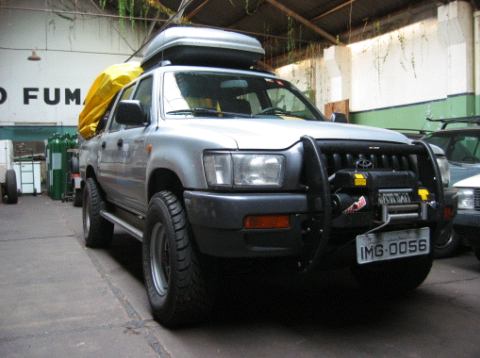
'La Poderosa' in Montevideo, ready to go
The first thrill came in Montevideo where I met with “La Poderosa” our 4-wheel drive Toyota Hi-lux pickup truck, equipped with extra big wheels, and a device to pull ourselves out of the mud in case of emergency. What an impressive gear! Just in time to give a small symbolic helping hand for the final touch, loading the boat on the trailer. Next day Sarian, Gissel, Susana and Soledad would be driving it all the way down 3000 km to Tierra del Fuego, while I stayed comfortably in Montevideo to set up a new insitute with Nestor, and work with Carla on her thesis.
Five days later when I arrived in Ushuaia by plane it felt like a small miracle when we met. Everything had worked out, and we where ready to go. Well, first load the last things on La Poderosa, fix all the ropes and all. Heavy stuff. No wonder that on the trip down, it had happened several times that the girls where approached by puzzled Argentinians asking “so ..… where are the men?”. We drove up to a hotel that Gissell had reserved. Well chosen Gissell. A beautifull place on the shores of a huge lake. I will not write about details such as the champagne, the aqua massage, the spider crabs and Argentinian beef, and just assure you that it was a relatively cheap hotel, with a fantastically helpful staf that accomodated all our strange requests such as guarding samples and stuffing one of the huge trouts we caught with delicacies and serving it with vegetables and cream. From this strategic base camp we worked the rest of the days.
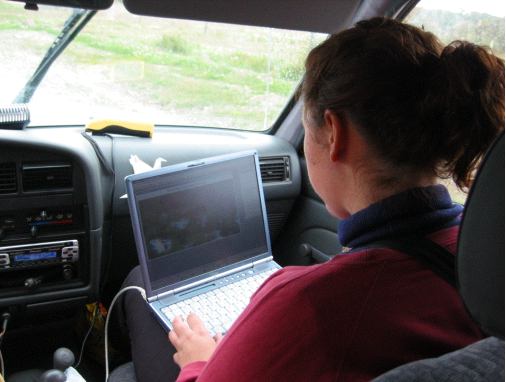
High tech co-piloting by Gissell projecting our gps coordinates real time on downloaded satellite images
Lake hunting
The first day we went lake hunting without the trailer. Sarian had as always selected promising lakes from satellite images, but now we needed to check them out in the field. Can they be reached? Are they not to deep or too salty? Will the owner give permission? First we went for a cluster of lakes that Sarian had spotted on the southern tip of the island. Alas after hours of driving along bumpy trails through breathtaking landscapes we were not even half the way, when the track ended. No problem, we had another cluster of abundant lakes in mind around the town of Rio Grande. When we arrived there at the end of the afternoon, finding the lakes we had identified on the satellite image was not that easy, but here our high tech gear came handy. Gissell had the laptop connected to the gps of Sarian, and a handy piece of software allowed us to see the car as a red spot moving over the satellite images. Several times this helped us finding out that we were actually driving in the opposite direction than we had assumed. Great technology! Unfortunately, all these promising lakes appeared saline, so we returned to the hotel that night without any suitable lake on our list.
Fortunately, the owner of the hotel contacted a couple that served as guides for horseback tours and other outdoor activities. They were our salvation. One hour of talking to them and studying our satellite images together helped us identify a good set of potentially suitable lakes, not too far from our hotel. Next day, was stormy, cold and terribly rainy, but the success of our second lake hunting trip that day compensated easily for that inconvenience. Three of the four lakes were not only suitable, but also beautifully located, and all three quite different. We returned home excited and happy.
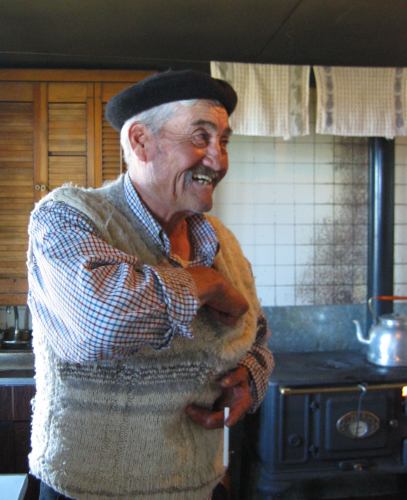
The first gaucho
Ready to go my first SALGA lake. Breakfast at seven, and off we went. Lake 71, locally known as Lago del Pescado, was located on private land, but the care-taker felt confident enough to give us permission without asking his boss. That was quite something as as his boss was apparently a powerfull man ('el corte el bacalao GRANDE', he cuts BIG fish). I had heard much stories of Sarian and Gissell's meetings with special people on the expedition. Here was my first close encounter. This was a proud man ('I consider myself a gaucho') in his seventies who's crushing hand shake illustrated to each of us individually that he was still going strong. The only bad experience we had with him is that he had locked the shed where he kindly hosted our field lab, and left for a drink in the village, leaving us in the cold at nine at night after a long day of field work. We did not want to leave, as our samples were still there and needed to go into a freezer. When he finally came home an hour later he was too drunk to walk straight (although driving the car went just fine). Although we were obviously annoyed we thanked him as friendly as possible for coming home and unlocking our lab. Next day when he invited us to a cup of coffee brewed on his wood-oven and told us about his life we got a better perspective. He had lived there lonely in the forest for many years. One day he was offered a job in San Sebastian, 300 km north. He traveled on horseback through the peatlands and over the mountains sleeping in the forest for weeks, to finally find out that the person that had offered him work did not turn up. Two months later, and quite tired our friend was back to where he came from, and stayed for the rest of his life. When we left for the next lake we could read the emotion in his face, sad as so many lonely people living in the countryside that had seen the SALGA team coming and going.
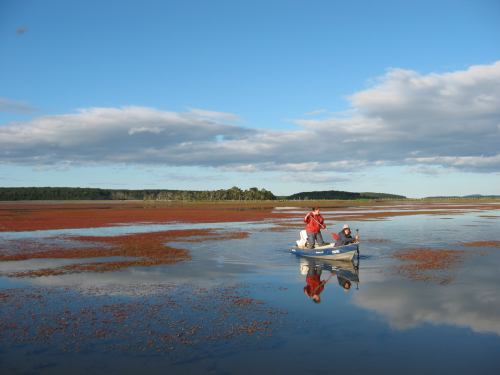
Macrophytes and shallow water in lake 71 made it hard to use the motor

The road through Andean heathland to lake 71
The first lake
We sampled Lake 71 on a beautifull day. It was a classical vegetation dominated shallow lake. Crystal clear water, extensive fields of submerged plants covering most of its surface area and an average depth of not much more than one meter. The lake was located in extensive plains covered with so-called Andean heathland, a bumpy vegetation due to the hemispherical compact cushions the size of half football formed by a peculiar plant that is typical of fields that are often frozen. Patches of ancient forest and remote mountains with snow complete the magic landscape in which guanaco's grazed, smal foxes hunted and rufus billed ibis and other birds cheered up the soundscape. The first water samples made Gissell shout out a exited victory call: this lake is full of tremendously large zooplankton, huge black copepods and Daphnids too. This is what we had predicted for the south, but getting this image confirmed so vividly was an emotional moment. The other image confirmed in a spectacular way was that of the fish community. Raising the nets in the morning we found five huge trouts (the biggest one 3 kg) and no small fish at all. I looked forward to eating one of those, but Gissell had already given all of them away to locals, except for the formol preserved ones….. When she realized my culinary fascination she felt really bad about this. (Will I ever get my thesis approved now?). It would take two lakes more to solve this tension, producing a good trout for our cook to prepare.

The trout that saved Gissells PhD in lake 73
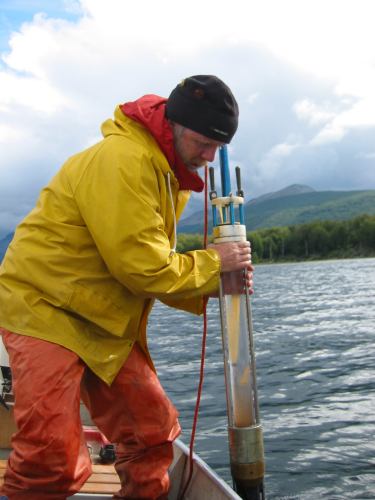
Marten taking out a sediment core
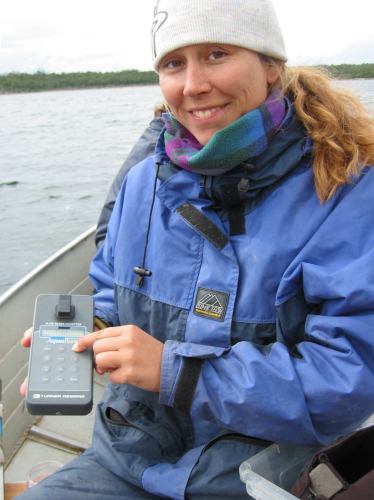
Sarian showing the high tech field fluorimeter
So how precisely do you sample a lake?
Before I go on, let me tell you what we really do at a lake. Our term 'snapshot sampling' is quite an understatement of the massive effort put in a single lake in the field. We sample about all living things as well as the water and the sediment. Here is a short version of how it goes. After unpacking our stuff at the shore, two go sampling the water by boat, while the remaning ones set up the field lab in a tent we brought, or a nearby shed or house. The boat crew samples the entire water column by means of a 2 m tube in 20 points that have been randomly selected by the computer. Getting the resulting two large barrels of mixed water takes a few hours and is quite a heavy job. In the field lab some chemical properties of the water are measured directly. Then the water is filtrated by means of an electrical pump (fed by a field generator) in portions for determining chlorophyll and zooplankton, while fractions are kept for stable isotope analysis, and analysis of chemical composition, bacteria, and protozoans. While Gissell does all this the next boat trip is dedicated to mapping and the macrophytes and the depth along five transects. The gps records each position, while we take samples of macrophytes for the herbarium and stable isotope analysis, and measure the depth, the Secchi depth, and with a high tech device also the fluorescence and turbidity. At mid-day the thermal and oxigen profile of the water column is determined at the deepest point. This is also the point where we go for the sediment samples. This is a lot of work, and dirty and heavy too, but it is worth it, as it will allow us later to read back the history of the lake for centuries. With some ingenious devices that Andy Lotter lent us we first take various samples of the top 2 cm and of the 2 cm below layer. From those we will later determine traces of different pollutants, as well as nutrients, organic matter content, and biological characteristics such as the amount of resting eggs of zooplankton. The we try to take two long sediment cores that should latter tell us the longer history of the lake. These are well sealed at the shore and should be kept in vertical position for the rest of the trip. In the mean time the fishing gear is prepared by the crew on the shore. Nets with different mesh sizes and the 'minnow traps' for small fishes are put out by boat at night, and recovered first thing in the morning. Then all fish are measured and weighted, their stomach content analysed, and a sample of dorsal muscle is taken for stable isotope analysis later (telling us what the fish has been eating). Samples of all species are preserved in formol for identification by specialists later. Getting everything packed onto the truck and the trailer is the final challenge, and usually takes a few hours too. Now I understand why the team only sleeps in the tent if it is really necessary. You do feel like taking a shower and sleeping in a real bed after such days.
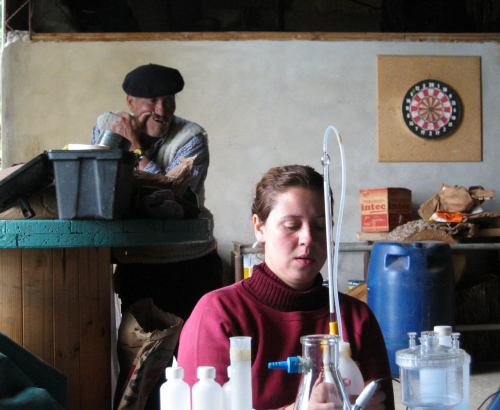
A gaucho hosts Gissell's field lab in his shed
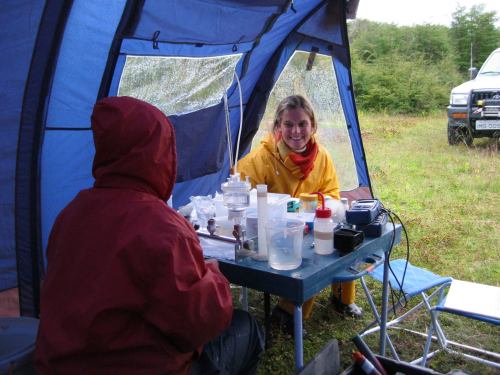
Gissell and Soledad in the field lab on a rainy day
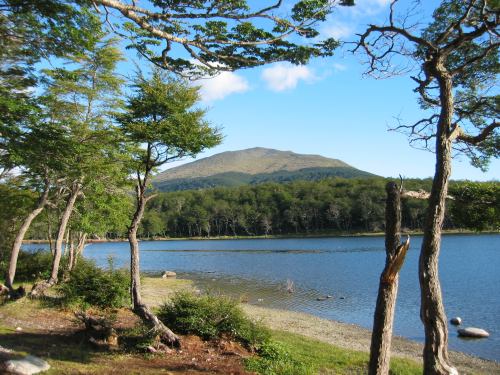
Lake 72 after the rain and the bbq parties stopped
Living in this wheather without cloths?
I kept thinking of Darwin's descriptions of this land, its nature, its climate and its inhabitants. While the landscapes are breathtaking, the weather in summer is actually much more like Dutch wheather than I had imagined. It is a bit colder of course, but it rains less than in Holland. The strange thing is that the changes in wheather are extremely fast. Reading the sky to predict that it will be a fine day does not work here. In a few hours a warm and sunny day can turn into one with very heavy winds and cold rain. One of the most striking things thinking of Darwin's descriptions is that the original inhabitants wore little cloth at all, and lived in very simple huts. How did they do that in a place where lakes are frozen several months in winter, and storms are notoriously severe. Appparently they used a mix of animal fat and clay to cover themselves with a thick isolating cream, but nonetheless. Unfortunately, as in many places in South America, few aboriginals have survived the slaughter and diseases brought about by the European invaders that arrived about 12000 years later than the first humans crossing over from Asia around the end of the last glaciation.

Two lakes and a forest, how much history have they seen?
Our second lake was on public land, and when we came on Sunday it was crowded with families, camping and cooking on small campfires. I gave a television interview to a journalist of the local tv-channel that happened to be there, and we explained to many curious by-standers what we were doing and why. As always people find it a beautifull enterprise. The lake was surrounded by forest and quite different from the first one, although we found the same kinds of aquatic plants. The fluffy sediment allowed Susana and me to take out sediment cores with record lengths of 70-80 cm. The history of how many years would be captured in those cores? The same question crossed my mind looking at the virgin forest with huge Notofagus trees. Where some of those trees already there when Darwin walked these hills? Where they perhaps even there when Colon discovered America? The answer came when we went to ask permission to enter the land on which our third lake was located. The owner of the woodmill explained that the largest trees had about 400-500 years. However those were not good for wood cutting, as they are already in decline, with many dead branches and rotting parts. They only harvested trees of 200-300 years. I was at the point of questioning him about the sustainability of this practise, but controlled myself, as we still needed access to his lake. Later I found out that the current forestry practise is actually at a quite low and roughly sustainable rate. Still it breaks your heart seeing anybody touching this virgin forest.
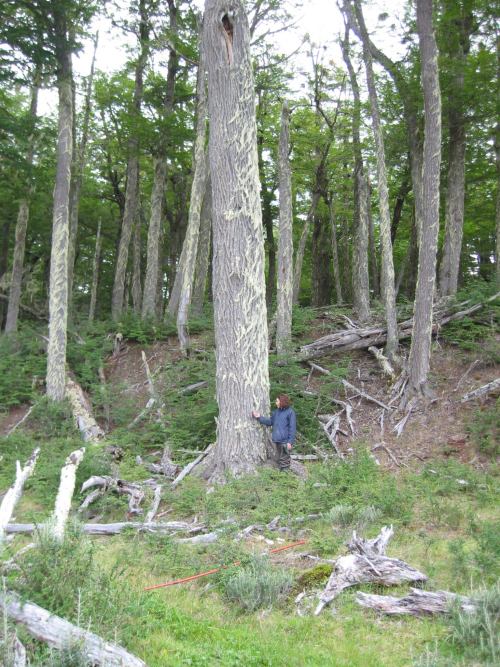
Susana contemplates a tree of about 400 years old

The final destiny of many of the Notofagus trees
To sample the lake on the land of the forester we had to cross two rivers deep enough to let the water wash over the hood of our truck. Clearly the four wheel drive was no exagerated luxery at all here. We would never have been able to get out of the gravelly river bed without it. On the lake itself we had to tolerate some cold and rainy wheather. However, as usually it paid off. What we got to see was a spectacularly cristalline and oligotrophic lake with big trouts, and a spectacular rainbow made us easily forget the cold rain.
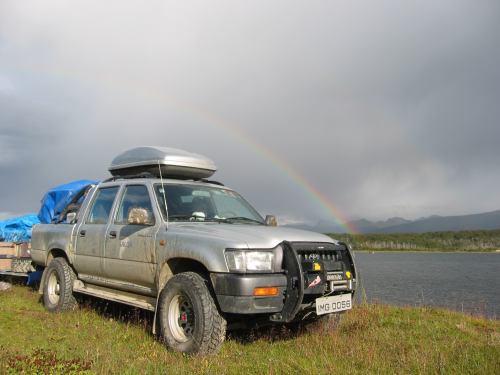
Here comes the sun, after some heavy showers at lake 73
Impressed
Returning home, flying from the subantarctic summer throught subtropical Argentina and Spain to our Dutch temperate winter, I am tired, but happy, and above all impressed. Impressed by the landscapes, the lakes and the trees, but especially by Gissell and Sarian. Few people combine the power, patience and creativity needed to do this heavy work and solve the endless series of small and large unexpected problems on the way. These girls are the heart (and the brains and the muscles) of the project. They are just unbelievable.
Previous | Overview | Next














